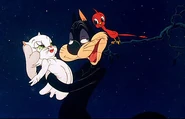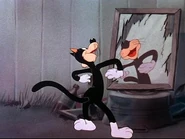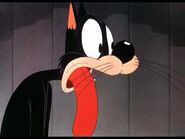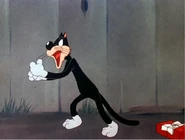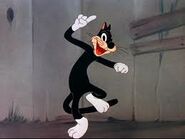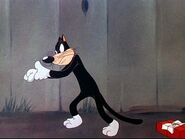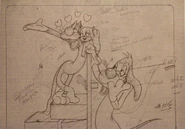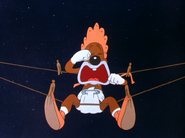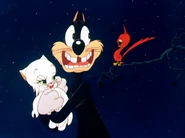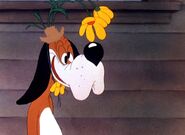TheBigGnome (talk | contribs) (credit on artist's page) |
TheBigGnome (talk | contribs) No edit summary |
||
| (19 intermediate revisions by 7 users not shown) | |||
| Line 1: | Line 1: | ||
{{PrevNext |
{{PrevNext |
||
| − | |Prev = |
+ | |Prev = Double Chaser |
| − | |Prev1 = |
+ | |Prev1 = Double Chaser |
|Shorts = Proto-Sylvester Cartoons |
|Shorts = Proto-Sylvester Cartoons |
||
|Next = The Fifth-Column Mouse |
|Next = The Fifth-Column Mouse |
||
| Line 12: | Line 12: | ||
|airdate = October 3, 1942 |
|airdate = October 3, 1942 |
||
|series = [[Looney Tunes]] |
|series = [[Looney Tunes]] |
||
| − | |Voice = [[Mel Blanc |
+ | |Voice = [[Mel Blanc]] (uncredited)<br>[[Sara Berner]] (uncredited)<br>[[Kent Rogers]] (uncredited)<ref>http://likelylooneymostlymerrie.blogspot.com/2015/08/384-hep-cat-1942.html</ref> |
|Starring = Hep Cat<br>Rosebud the Dog<br>Bird |
|Starring = Hep Cat<br>Rosebud the Dog<br>Bird |
||
|previous = [[The Dover Boys]] |
|previous = [[The Dover Boys]] |
||
|next = [[The Sheepish Wolf]] |
|next = [[The Sheepish Wolf]] |
||
| − | |video = [[File:Looney Tunes |
+ | |video = [[File:Looney Tunes Blue Ribbon - The Hep Cat|thumb|center|280px]] |
| − | [[File:Looney Tunes Blue Ribbon - The Hep Cat|thumb|center|280px]] |
||
[[File:The Hep Cat (1942) with recreated titles|thumb|center|280px]] |
[[File:The Hep Cat (1942) with recreated titles|thumb|center|280px]] |
||
|Writer = [[Warren Foster]] |
|Writer = [[Warren Foster]] |
||
| − | |Animators = [[Robert McKimson|Bob McKimson]] |
+ | |Animators = [[Robert McKimson|Bob McKimson]]<br>[[Rod Scribner]] (uncredited)<br>[[Virgil Ross]] (uncredited)<ref>https://www.imdb.com/title/tt0034845/fullcredits/?ref_=tt_ov_st_sm</ref><br>[[Sid Sutherland]] (uncredited) |
|Layout-artist = |
|Layout-artist = |
||
|Background-artist = [[John Didrik Johnsen]] (uncredited) |
|Background-artist = [[John Didrik Johnsen]] (uncredited) |
||
|Sound effects = [[Treg Brown]] (uncredited) |
|Sound effects = [[Treg Brown]] (uncredited) |
||
| − | |Musician = [[Carl W. Stalling]] |
+ | |Musician = [[Carl W. Stalling]] |
| + | }} |
||
'''The Hep Cat''' is a [[1942]] ''[[Looney Tunes]]'' short directed by [[Bob Clampett]]. |
'''The Hep Cat''' is a [[1942]] ''[[Looney Tunes]]'' short directed by [[Bob Clampett]]. |
||
== Plot == |
== Plot == |
||
| − | + | A [[Proto-Sylvester|cat]] strolls through an abandoned lot. Unfortunately, he stumbles across a dog named [[Willoughby|Rosebud]]. Upon noticing the cat, he gives chase. The cat, after a successful escape, begins singing "Java Jive". Later, the cat encounters an attractive female cat, and attempts to woo her, failing utterly. Suddenly, Rosebud the dog reappears, and the chase resumes. The cat once again evades the dog. The cat kisses his dream girl, a puppet. |
|
| − | == Clampett's |
+ | == Clampett's Direction == |
According to Milton Gray, beginning from this cartoon, Bob Clampett's creativity and experimentation reaches his peak, as subsequent ''Looney Tunes'' cartoons became wilder, zanier, and loonier in tone, direction and timing <ref>https://www.youtube.com/watch?v=rZce6l9HGgk</ref>. In cartoons Clampett directed after this one such as "[[A Tale of Two Kitties]]" or "[[A Corny Concerto]]", there is a notable increase in violence, irreverent humor, more exaggerated double takes and surrealism. |
According to Milton Gray, beginning from this cartoon, Bob Clampett's creativity and experimentation reaches his peak, as subsequent ''Looney Tunes'' cartoons became wilder, zanier, and loonier in tone, direction and timing <ref>https://www.youtube.com/watch?v=rZce6l9HGgk</ref>. In cartoons Clampett directed after this one such as "[[A Tale of Two Kitties]]" or "[[A Corny Concerto]]", there is a notable increase in violence, irreverent humor, more exaggerated double takes and surrealism. |
||
| Line 40: | Line 40: | ||
* DVD - ''Looney Tunes Spotlight Collection: Volume 2'', Disc 2 |
* DVD - ''Looney Tunes Spotlight Collection: Volume 2'', Disc 2 |
||
* Blu-ray, DVD - ''[[Looney Tunes Platinum Collection: Volume 3]]'', Disc 1 |
* Blu-ray, DVD - ''[[Looney Tunes Platinum Collection: Volume 3]]'', Disc 1 |
||
| − | * DVD - ''The Big Street'' (USA 1995 Turner dubbed print |
+ | * DVD - ''The Big Street'' (USA 1995 Turner dubbed print) |
| + | * Streaming - [[HBO Max]] |
||
== Notes == |
== Notes == |
||
| − | * This cartoon is |
+ | * This cartoon is the first ''[[Looney Tunes]]'' short to be produced in color. |
* This cartoon was re-released into the Blue Ribbon ''[[Merrie Melodies]]'' program on November 12, [[1949]]. |
* This cartoon was re-released into the Blue Ribbon ''[[Merrie Melodies]]'' program on November 12, [[1949]]. |
||
| − | * A cultural reference is made when the cat claims to be a ''"gorgeous hunk of man"'', as his face turns into a caricature of Victor Mature. As the cat feels Rosebud's hand beside the puppet he's kissing he exclaims, ''"Ah, something new has been added!"'' At the end of the cartoon the cat says, ''"Well, I can dream, can't I?"'' Both quotes were used often in ''Looney Tunes'' cartoons of this era (like for instance "[[Plane Daffy]]") and are both catch phrases by Jerry Colonna. ''"Ah, something new has been added"'' was a slogan for Old Gold (cigarette). |
+ | * A cultural reference is made when the cat claims to be a ''"gorgeous hunk of man"'', as his face turns into a [[Caricatures|caricature]] of Victor Mature. As the cat feels Rosebud's hand beside the puppet he's kissing he exclaims, ''"Ah, something new has been added!"'' At the end of the cartoon the cat says, ''"Well, I can dream, can't I?"'' Both quotes were used often in ''Looney Tunes'' cartoons of this era (like for instance "[[Plane Daffy]]") and are both catch phrases by Jerry Colonna. ''"Ah, something new has been added"'' was a slogan for Old Gold (cigarette). |
| − | * When [[Cartoon Network]] aired this short on ''[[The Bob Clampett Show]]'', the titles were replaced with title cards of a colorized [[Porky Pig]] ''Looney Tune'', with "[[The Merry-Go-Round Broke Down]]" as the opening music. The ''Looney Tunes'' title card cuts to the Blue Ribbon title card with "[[Merrily We Roll Along]]" as title music. The ''Looney Tunes'' drum with [[Porky Pig]] saying "[[ |
+ | * When [[Cartoon Network]] aired this short on ''[[The Bob Clampett Show]]'', the titles were replaced with title cards of a colorized [[Porky Pig]] ''Looney Tune'', with "[[The Merry-Go-Round Broke Down]]" as the opening music. The ''Looney Tunes'' title card cuts to the Blue Ribbon title card with "[[Merrily We Roll Along]]" as title music. The ''Looney Tunes'' drum with [[Porky Pig]] saying "[[That's all Folks!]]" also closes the cartoon. This was done to identify the short as a ''Looney Tune'', since the Blue Ribbon titles miscredited the short as a ''Merrie Melodie''. |
| − | + | ** The opening title cards aired on ''The Bob Clampett Show'' are not correct, since the 1942-43 season was the first in which ''Looney Tunes'' cartoons opened with the "bulls-eye" titles, usually with thicker rings. Since the original titles are lost, the restored version on DVD and Blu-ray use the Blue Ribbon titles instead of the original titles. |
|
== Gallery == |
== Gallery == |
||
| Line 57: | Line 58: | ||
Hepcat4.jpeg |
Hepcat4.jpeg |
||
Hepcat3.jpg |
Hepcat3.jpg |
||
| + | tumblr_pgj3flL4dr1s92nono1_1280.jpg |
||
| + | Screen Shot 2015-08-15 at 23.35.26.png |
||
| + | colonna cat.png|"Well, I can dream, can't I?" |
||
| + | milt gross like dog.jpg |
||
</gallery> |
</gallery> |
||
| Line 64: | Line 69: | ||
== References == |
== References == |
||
<references /> |
<references /> |
||
| + | |||
| + | |||
{{DEFAULTSORT:Hep Cat, The}} |
{{DEFAULTSORT:Hep Cat, The}} |
||
| Line 74: | Line 81: | ||
[[Category:Cartoons written by Warren Foster]] |
[[Category:Cartoons written by Warren Foster]] |
||
[[Category:Cartoons with characters voiced by Mel Blanc]] |
[[Category:Cartoons with characters voiced by Mel Blanc]] |
||
| − | [[Category:Cartoons with characters voiced by Bea Benaderet]] |
||
[[Category:Cartoons with characters voiced by Kent Rogers]] |
[[Category:Cartoons with characters voiced by Kent Rogers]] |
||
[[Category:Cartoons with backgrounds by John Didrik Johnsen]] |
[[Category:Cartoons with backgrounds by John Didrik Johnsen]] |
||
Revision as of 12:13, 5 September 2020
| ← Double Chaser | Proto-Sylvester Cartoons | The Fifth-Column Mouse → |
Template:Infobox Shorts wTabs The Hep Cat is a 1942 Looney Tunes short directed by Bob Clampett.
Plot
A cat strolls through an abandoned lot. Unfortunately, he stumbles across a dog named Rosebud. Upon noticing the cat, he gives chase. The cat, after a successful escape, begins singing "Java Jive". Later, the cat encounters an attractive female cat, and attempts to woo her, failing utterly. Suddenly, Rosebud the dog reappears, and the chase resumes. The cat once again evades the dog. The cat kisses his dream girl, a puppet.
Clampett's Direction
According to Milton Gray, beginning from this cartoon, Bob Clampett's creativity and experimentation reaches his peak, as subsequent Looney Tunes cartoons became wilder, zanier, and loonier in tone, direction and timing [1]. In cartoons Clampett directed after this one such as "A Tale of Two Kitties" or "A Corny Concerto", there is a notable increase in violence, irreverent humor, more exaggerated double takes and surrealism.
Availability
- VHS - Cartoon Moviestars: Daffy Duck and Company
- LaserDisc - The Golden Age of Looney Tunes Volume 1, Side 4: Bob Clampett
- VHS - The Golden Age of Looney Tunes Volume 4: Bob Clampett
- DVD - Looney Tunes Golden Collection: Volume 2, Disc 4
- DVD - Looney Tunes Spotlight Collection: Volume 2, Disc 2
- Blu-ray, DVD - Looney Tunes Platinum Collection: Volume 3, Disc 1
- DVD - The Big Street (USA 1995 Turner dubbed print)
- Streaming - HBO Max
Notes
- This cartoon is the first Looney Tunes short to be produced in color.
- This cartoon was re-released into the Blue Ribbon Merrie Melodies program on November 12, 1949.
- A cultural reference is made when the cat claims to be a "gorgeous hunk of man", as his face turns into a caricature of Victor Mature. As the cat feels Rosebud's hand beside the puppet he's kissing he exclaims, "Ah, something new has been added!" At the end of the cartoon the cat says, "Well, I can dream, can't I?" Both quotes were used often in Looney Tunes cartoons of this era (like for instance "Plane Daffy") and are both catch phrases by Jerry Colonna. "Ah, something new has been added" was a slogan for Old Gold (cigarette).
- When Cartoon Network aired this short on The Bob Clampett Show, the titles were replaced with title cards of a colorized Porky Pig Looney Tune, with "The Merry-Go-Round Broke Down" as the opening music. The Looney Tunes title card cuts to the Blue Ribbon title card with "Merrily We Roll Along" as title music. The Looney Tunes drum with Porky Pig saying "That's all Folks!" also closes the cartoon. This was done to identify the short as a Looney Tune, since the Blue Ribbon titles miscredited the short as a Merrie Melodie.
- The opening title cards aired on The Bob Clampett Show are not correct, since the 1942-43 season was the first in which Looney Tunes cartoons opened with the "bulls-eye" titles, usually with thicker rings. Since the original titles are lost, the restored version on DVD and Blu-ray use the Blue Ribbon titles instead of the original titles.
Gallery
External Links
- The Hep Cat at SuperCartoons.net.

